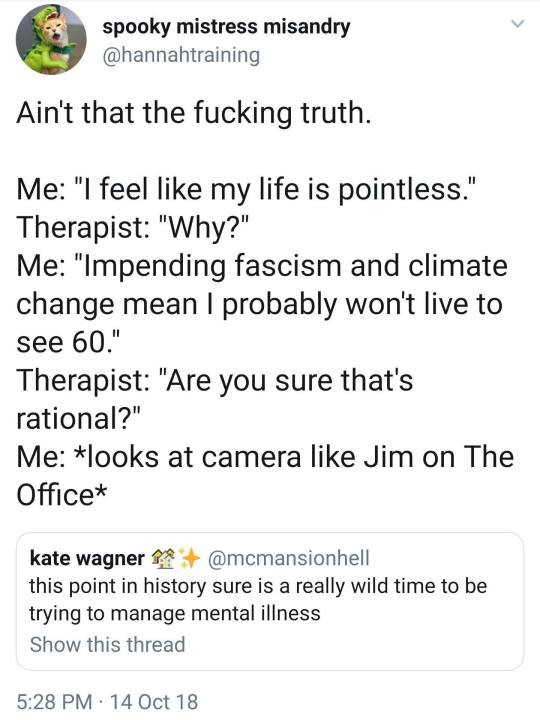Text
solved the paradox of the ship of Theseus btw!! turns out the answer was “it depends”. hope that helps, have a good weekend everybody!
40K notes
·
View notes
Text
OK THIS IS NOT A FUCKING DRILL EVERYONE FUCKING REPEAT AFTER ME. THIS IS WHAT YOU WILL DO WHEN YOU WATCH MUPPET CHRISTMAS CAROL THIS YEAR:
You will navigate to the page on disney plus (and it has to be here. Unless someone has actually uploaded the REAL movie anywhere else you cannot get it elsewhere)
BUT YOU WILL NOT HIT PLAY. You won’t do it. Because it’s NOT THE REAL VERSION OF THE FILM AND DISNEY IS FUCKING LYING TO YOU AS IT ALWAYS DOES
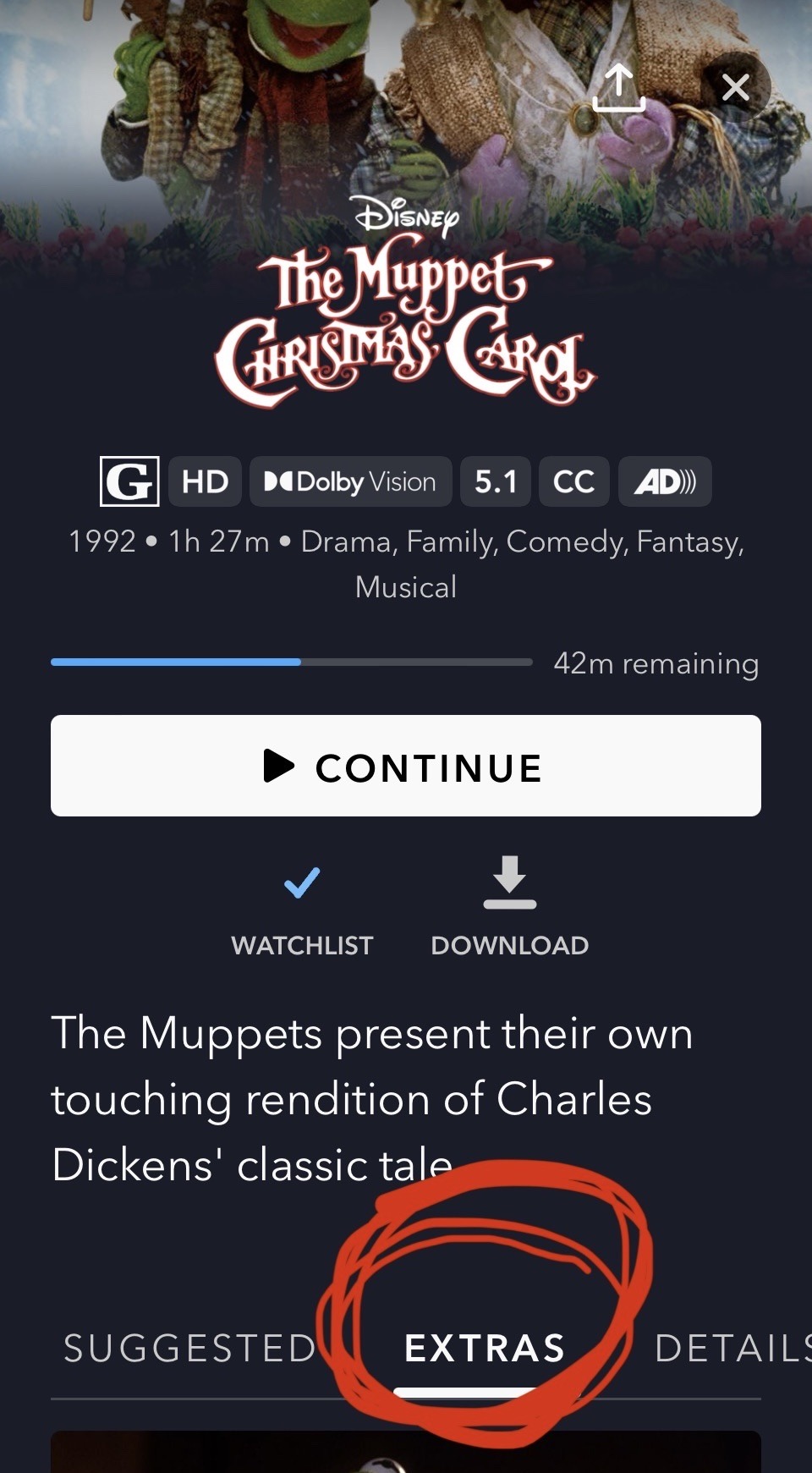
You will scroll down HERE. To EXTRAS instead. You MUST GO HERE. This is non -negotiable

THEN YOU WILL SCROLL DOWN TO THE BOTTOM OF THE EXTRAS AND YOU WILL THEN HIT PLAY ON THIS BAD BOY: THE FULL LENGTH VERSION
And you will watch it. And you will thank me for having been so blind and led astray by that stupid fucking mouse. You’re welcome.
#yes to all of this#I was absolutely devastated and furious the first time I accidentally watched this movie without the song in it#Never again. When Love Is Gone or riot#love this movie so much#muppet christmas carol
45K notes
·
View notes
Text
This post is your reminder that you are not obligated to blog about current events.
Things are bad. Really bad. Do not let people guilt trip you into tormenting yourself even further over the fact that things are bad. Doomscrolling is not activism.
If you're just on tumblr to blorbopost or reblog pretty pictures, you are not harming people by inaction.
You are not a bad person for not dedicating every aspect of your life and leisure space to whatever disgusting mask-off attack on human life and dignity some government has decided to enact.
Take action where you can, but don't confuse doomscrolling and digital self harm for action.
If you need to lose yourself in blorboposting, go for it.
If you need to log off for the day, whether it's to take irl action or to protect what little sanity any of us have left over the past 7 years, then by all means, do.
Morale is important. Hope is important. Small joys keep us from burning out completely in times like this. Do not let any "if you don't reblog this I'm judging you" guilt trip convince you otherwise.
57K notes
·
View notes
Text
california quails they’re unforgettable. small and round, black feather on top.

45K notes
·
View notes
Text


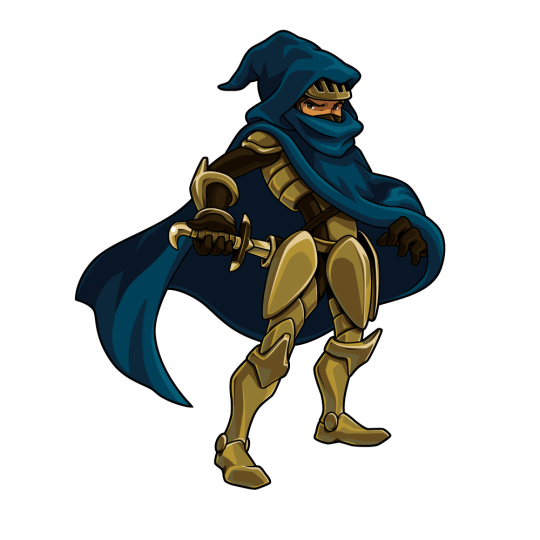
I can't remember if I ever drew this observation, but I sure as hell talked about it before: Specter Knight very clearly is wearing a helmet. Meanwhile his past, alive counterpart looks to be donning a ski mask with a metal visor super glued to the top and you can't convince me otherwise.
~~~~~~~~~~~~~~~~~~~~~~~~~~~~~~~~~~~~~~~~~~~~~~~~~~~~~~~~~~~~~~~
⭐Prince Marine: The Dandy Robot / Art Commission / Ko-Fi / Itch.io / Bluesky⭐
114 notes
·
View notes
Text
I gotta say, one of the greatest achievements of my 20s was that I learned (mostly) to differentiate between:
"I truly do not want to go" and
"I'm just feeling the Demand Avoidance, and I will like it once I get there."
70K notes
·
View notes
Text
Dear scientists,
Please, for the love of God, please, make your papers more understandable.
Fuck you
Sincerely,
A college student on the verge of tears
27K notes
·
View notes
Text
Explaining stuff plays a very important role in fiction writing, particularly fantasy/sci-fi. Anything in your setting that is different from your audience's real life (aka: probably the vast majority of it) will need to be explained to them in one way or another. You can "show don't tell" a lot of it, but if you have a sentence like "It was custom for the Glorpians to not show their name badges to anyone except close friends and family," it sure would take a lot of words to properly scaffold/depict that cultural practice. If that's Not What Your Story Is About, it's completely fine to use a shorter sentence so you can focus on the important stuff.
The one caveat is that the stuff you "show don't tell" is more likely to emotionally resonate with your audience. That's fine and normal-- people are naturally going to lend more credence to the things they figure out themselves over the stuff you tell them. It's just human nature. But there is power in this truth! If you explain the default assumptions of your world concisely, this gives you power to combine and juxtapose them interestingly later. "Tell" the premises to the audience, combine them in a logical way, and you will have "shown" the emotional truths of your story through deductive logic.
Consider a story about the Glorpians again. You want to convey the depth and nuance of Glorpian romance, so you open a blank word doc and type the following words:
Tell: "Glorpians have deep and nuanced relationships with each other."
This sentence probably doesn't resonate with your audience -- they don't have the context to understand what this means or to feel emotions about it. Consider the alternative:
Tell: Glorpians never show their name badges to anyone but close friends and family.
Tell: Blorpia showed her name card to Florpio way earlier in their relationship than he was expecting.
Tell: Florpio felt uncomfortable at this display of affection and distanced himself accordingly.
Tell: Blorpia was heartbroken and vowed never to show her name badge to anyone again.
Tell: Klorpio saw Blorpia crying at a bus station and, since he was young and naive, showed his name badge to her as a gesture to cheer her up.
How does Blorpia respond to this? Good question! You now have a plot with characterization and tension. And in the process of telling those base story facts, you've now Shown the truth you stated earlier, which is that Glorpians have deep and nuanced relationships with each other.
Long story short, the more puzzle pieces you tell your readers, the more options you have for combining them in interesting ways later. And the more time you spend showing/reinforcing the way those pieces connect, the more they'll resonate with audiences. Cultural differences can make communication challenging because of the lack of common ground, but that difficult communication is all the more valuable because it has the power to challenge people's assumptions. And readers who are willing to broaden their horizons will likely find those works to be immensely valuable as a result.
“[The older generation of writers who had established the rules for modern fiction under the assumption that their experience was “universal”] gained the ability to write stories where they could “show” and not “tell" … They had this ability not because they were masterful stylists of language or because they dripped with innate talent. The power to “show, not tell” stemmed from the writing for an audience that shared so many assumptions with them that the audience would feel that those settings and stories were “universal.” (It’s the same hubris that led the white Western establishment to assume its medicine, science, and values superior to all other cultures …) Look at the literary fiction techniques that are supposedly the hallmarks of good writing: nearly all of them rely not on what was said, but on what is left unsaid. Always come at things sideways; don’t be too direct, too pat, or too slick. Lead the reader in a direction but allow them to come to the conclusion. Ask the question but don’t state the answer too baldly. Leave things open to interpretation… but not too open, of course, or you have chaos. Make allusions and references to the works of the literary canon, the Bible, and familiar events of history to add a layer of evocation—but don’t make it too obvious or you’re copycatting. These are the do’s and don’ts of MFA programs everywhere. They rely on a shared pool of knowledge and cultural assumptions so that the words left unsaid are powerfully communicated. I am not saying this is not a worthwhile experience as reader or writer, but I am saying anointing it the pinnacle of “craft” leaves out any voice, genre, or experience that falls outside the status quo. The inverse is also true, then: writing about any experience that is “foreign” to that body of shared knowledge is too often deemed less worthy because to make it understandable to the mainstream takes a lot of explanation. Which we’ve been taught is bad writing!”
— — Cecilia Tan, from Uncanny Magainze 18 (via violetephemera)
8K notes
·
View notes
Text
In Defense of Toby Fox’s Halloween Hack
Twitter is all in a tizzy about the Halloween Hack as of late. The apparent reason for this is because the Halloween Hack uses a word commonly used as a homophobic slur, not taking into account that the hack was created in 2008 (when the internet was a different place) and that 2008 was 14+ years ago (and people are known to grow and change over this time). There appears to be some amount of discussion over whether Toby Fox should be “cancelled” for this.
I’ve seen a fair bit of banter from both sides on this, but what I haven’t seen people on the internet talk about is the CONTEXT of the game in which this word is used. And while I don’t spend a lot of time talking about HH due to Toby’s stated embarrassment when people draw attention to it, if the internet’s gonna go dig up old drama for some reason, then by golly, I’m going to go dig up my old love for this game.
So if you want to come take a wild ride through some internet history and literary analysis, then go buckle your seatbelt and click the Readmore.
(content warning: discussion of homophobic slurs)
A quick bit about me: I am an adult on the internet, and I fall into the original Halloween Hack (hereafter abbreviated as HH)’s target demographic: teenagers who existed on Starmen.net, an Earthbound fan website, in 2008. I am also a current admin for Starmen.net, which puts me in a good position to comment on the history and culture of the site as a whole, and how that ties into the reception of HH.
Starmen.net has a long and rich tradition of events called Funfests, in which the site staff run a combination art/writing/music/etc contest for the site members, usually coalescing around a theme such as “Earthbound”, or sometimes “Winter” or “Halloween”. These events offer prizes such as forum avatar/rank privileges, and historically they sometimes even offered physical prizes. The 2008 Halloween funfest had an entire website made for it, which you can view here. Toby Fox submitted HH to this 2008 Halloween Funfest under the internet handle Radiation.
This is the context of HH: a passion project made by a teenager for a fan website full of other teenagers/twenty-somethings. If you go to a high school science fair, you could rightfully lambast every project for being undeserving of a Nobel Prize, but that’s not why we host high school science fairs OR Starmen.net Funfests. These events are an opportunity for teens to show what they are capable of and receive commendation from both their peers and a panel of judges selected specifically for this age demographic and venue.
For perspective, here’s what one of the hosts of the 2008 Funfest had to say about HH:
“Radiation nearly outclassed himself with this effort of skill labour and love. What a lot of fun. Despite getting repeatedly killed in the sewers this was one thoroughly enjoyabe hack. I Think I’ll go and play it again!”
HH won an award in the 2008 funfest-- a #1 in the “Most Effort” category. For some perspective, few people on Starmen.net go to the lengths of creating an entire game for a Funfest (and HH has a playtime of roughly 5-6 hours!). Of those who do, most of the resulting games are consistent with the output you would expect from a teenage userbase, since it’s not fair to expect teenagers to produce professional-quality work. That said, I can say with confidence that HH is a standout in the areas of both effort and quality.
Another thing that needs to be said of HH is that it is not a standalone game made in today’s modern game engines-- it is a hack of a preexisting game. Earthbound's codebase is notoriously complicated, and a lot of the tools that modern Earthbound hackers use to make their jobs easier (eg Coilsnake, Ebmused) didn’t exist in 2008. Toby had to do a lot of manual coding grunt-work to make HH, up to and including manually typing hexadecimal values into his computer in order to compose Megalovania. (Source: Toby wrote a really in-depth post about the process he used to make HH way back when, which I’m referring to here, but it’s unfortunately been deleted since then.)
I can imagine a hypothetical objection at this point: “ok but high effort homophobia is still homophobia”. In this post, I am also going to argue that Toby’s usage of this word can be considered artistic merit when taken in context, but you’ll have to bear with me for a bit while I explain that context. I’ll also talk about some of the cool and neat things this game does along the way because I think they’re worth talking about.
HH is, at its core, a derivative fan work of the video game Earthbound. And while I love Earthbound deeply, I also recognize that it’s a cult classic that not everyone has played. So while I encourage people to play the game I love deeply, I’ll also sum up a few relevant plot beats here so folks can understand the source material HH draws from:
--Ness, a thirteen year-old boy, meets a creature named Buzz Buzz from ten years in the future who tells him that an alien named Giygas has destroyed the world (direct quote: “All is devastation”). As such, Ness and his friends must save the world.
--One of Ness’s friends is a shy boy named Jeff with a penchant for shooting bottle rockets at enemies
--Jeff’s dad is an odd character named Dr. Andonuts. Dr. Andonuts is a reclusive scientist who lives in a snowy region called Winters who sent his son off to boarding school at a very young age. Andonuts’s lab includes no other signs of life, certainly not any indications of a wife/Jeff’s mother. Andonuts ends his conversation with Jeff by saying “Let’s get together in another ten years or so.”
--Towards the end of the game, Dr. Andonuts uses a device he created called a Phase Distorter to send Ness and his friends to the venue for the final battle. This is very clearly telegraphed as a one-way trip, as the kids’ brains are described in text as needing to be transplanted into robots to get there, but the kids go along with it anyway because the world is at stake.
--The kids go on to fight the final boss in a spectacle that words can’t do justice to here. All I’ll say is that after a long-fought battle, in the grace of an unexplained Deus Ex Machina, the souls of the four kids are impossibly returned to their bodies so they can enjoy their happy ending.
These are all canonical events that happen in the base game of Earthbound. Earthbound’s sequel, Mother 3, was released in 2006, two years prior to HH, although the English fan translation wasn’t released until around the time of the 2008 funfest, interestingly enough. Mother 3 does develop Dr. Andonuts’s canonical character somewhat, but I won’t discuss it in further detail here other than to say it mostly re-emphasizes his odd, solitary nature and his overly cavalier attitude towards his science experiments.
It’s also worth noting that in an oddball game like Earthbound, there are a lot of weird and funny idiosyncrasies to theorize on. There are pencil-shaped statues that block your way, which need to be removed with a device called a “pencil eraser.” Ness and his friends fight robots, aliens, and Krakens, but they also fight handbag-wielding ladies and walking mushrooms. Dr. Andonuts’s character oddities, while strange, fit nicely into the evenly distributed mesh of oddities that comprise Earthbound’s world.
Derivative works, particularly fan works, exist in conversation with the source material. They answer questions posed by the source, interpolate details left out of the original, and otherwise build on the world of the original in a collaborative way. This conversation sometimes happens in a one-on-one manner, between fan and original creator, but it also happens in conjunction with the fan community as a whole. When a theory takes traction, it will begin to appear in more and more fan works, growing in popularity and notoriety until it is “accepted” as the most common interpretation of canon’s strange idiosyncrasies. Newer or more fringe theories are less likely to be taken as a “default” interpretation, but they are more likely to be taken as “fresh” or “interesting” until/unless they, too, begin to gain traction.
HH exists in a few conversations: one with the source material, one with the fan community of Starmen.net (and the broader Earthbound community as a whole, although there was much more overlap between the two back in 2008), and one with Starmen.net’s Funfest culture. In order for HH to be well received by the Funfest judges, it would need to be aware of the community sensibilities as well as push the boundaries of the fan conversation with Earthbound as a whole-- a careful balancing act of being both interesting but also recognizable.
So, the fundamental fan question that HH tries to answer is “why is Dr. Andonuts LIKE THAT?”
This is an absolutely fair question, and Toby was certainly not the first to ask it, although his answer in the form of HH is one of the most high profile now.
HH is set in the world of Earthbound a few months after the final boss fight in autumn, but one where Ness and his friends did not magically return after their one-way trip to the final boss. Word has it that Dr. Andonuts has turned evil and must be defeated. On its surface, this is standard fare for a throwaway plot for a Funfest submission, but the magic of HH is that it does not treat this premise as a throwaway plot. It sets out to earnestly discuss why this happened by delving into Andonuts’s psyche.
Coming back to the idea of derivative works existing in conversation with the source material and interpolating unexplained details: Earthbound does not explain why Dr. Andonuts lives in solitude, nor does it give any hint as to the identity of Jeff’s mother. It also gives no indication as to why Andonuts didn’t seem to have bonded well with his son other than the handwavey explanation that Andonuts is just “like that”. HH initially poses the question of “why did Andonuts turn evil”, but leaves the reader to puzzle that out while battling monsters in Earthbound’s RPG engine.
At first, Toby offers a partial explanation: in HH, Dr. Andonuts is portrayed as feeling immense guilt at having sent his son into what he perceived as a death trap. (quote from the game: “The world is dead, and I’ve become senile with guilt and rage.” He also says stuff like “what’s the point in living without them”.) As such, he turned evil and created zombies to storm the world of Winters, causing a surge in refugees and desperate survivors. This is why the main character was sent to kill him.

(image transcription: a picture of a menu with the text “What do you do!?” followed with a single option: “Kill him”)
But in order to see the depth of this explanation, the true answer to the question “why is Dr. Andonuts LIKE THIS”, the player must hit “B” to cancel out of a menu at the correct moment, something Earthbound players tend to learn by habit from closing the equipment menu so many times, but never used as a plot-relevant mechanic in the base game. HH takes this subconscious muscle memory and turns it into a mechanic gating off half the game if you don’t “spare” the enemy, a precursor to the “spare” mechanic that would debut seven years later in Undertale.
When the player does this, they enter Dr. Andonuts’s “Magicant,” a dream-construct representing his inner psyche, with his hopes and dreams and fears all laid bare. The main character is tasked with finding Dr. Andonuts’s lost Courage. In the base game, Ness enters his own Magicant, so this feels familiar to a veteran player, but it also gives Toby the chance to more closely examine Dr. Andonuts’s character than he otherwise might be able to do.
Over the course of the rest of the game in Dr. Andonuts’s Magicant, the player continues to control the main character, a bounty hunter named Varik, but the NPCs in the game often mistakenly treat Varik as Andonuts. The dialogue we see from these NPCs reflects memories from Andonuts’s own life. We see a lot more characters try to make connections with Dr. Andonuts (”hey don’t you want to play baseball instead of doing math?”), but these are apparently rebuffed througout Andonuts’s life. One NPC guarding the entrance to the path leading to this lost Courage advises “Be careful. Be yourself.” We see memories of Dr. Andonuts’s presumed wife/Jeff’s mom, who is an OC Toby created for this work to answer the questions posed by canon.
Varik is tasked with fighting three “demons” behind three doors, where each demon is said to be stronger than the next. Since this segment takes place inside Andonuts’s mind, these are unsubtly implied to be Andonuts’s inner demons. The second and third doors represent Andonuts’s relationship with his son and his guilt over getting people killed; the first door is relevant to this post, so I’ll talk about it in more detail.
Inside the first door, Varik sees Andonuts’s memories of something called “Remember Me,” who despite being faced in a battle, is friendly and affectionate and causes no damage apart from being “hard to think about.” This enemy has a stock overworld sprite of a male NPC from the base game.
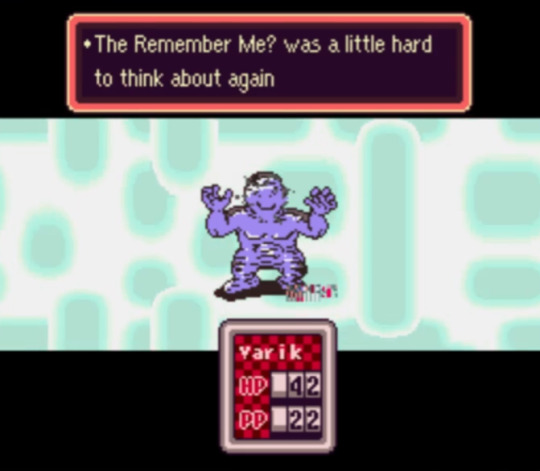
(image transcript: a smiling purple sprite in an Earthbound-style battle. The text box says “The Remember Me? was a little hard to think about again”)
At the end of this map, we see a cutscene in which it’s implied that Dr. Andonuts felt disconnected from his wife, perceiving her as an incessant insect. She says things like “Lately, you’ve been acting kind of... disinterested in me. Is there something wrong with me?” She asks if Dr. Andonuts has been hiding something from her, which triggers the following battle:

(image description: an Earthbound-esque battle against three enemies, each a sprite depicting a closeup of a man’s muscular body: a bicep, a chest, and a swimsuit-clothed groin area)
All three of these enemies are named NO. The music that plays in the background is deliberately unsettling, and their battle moves consist mostly of “flexing in a masculine way”, “slapping their buddies in a masculine fashion”, and “being hard to think about again”. After three turns, these enemies deliver a series of un-dodgeable moves that kill the player before it’s possible to defeat them, ending the game. The only way to proceed in the game is to select the Flee option in the menu.
To summarize the themes being presented here, Dr. Andonuts is gay and repressed his homosexuality to try to preserve his relationship with his wife due to his lack of courage. From a game design and literary merit standpoint, this NO battle is actually a really poignant way of portraying Andonuts’s mindset and all of the fears that kept him in the closet, portraying men’s bodies as an enemy that he must fight, or in failing to do so, must run from. Remember that Earthbound takes place in 199X-- none of the 1990′s were known for being especially tolerant of gay men, nor was 2008 when Toby made this hack; 2008 was the same year that California passed a bill intended to ban gay marriage. In another since-deleted web page, Toby said that one of his motivations for creating HH was “the lack of non-stereotypical, major homosexual characters in media”. With that in mind, this is a surprisingly sensitive portrayal of the pains of repressing one’s sexuality, especially from a teenager.
Toby also portrays some complexity in Andonuts’s relationship with his son Jeff, making the case that Andonuts helped Jeff in his fight against Giygas as a way of living vicariously through him to feel like less of a monster. From this standpoint, it’s easy to see that Andonuts’s abrasive language might be a defense mechanism for his own self esteem issues, calling others monsters to deflect from the fact he sees HIMSELF as a monster.
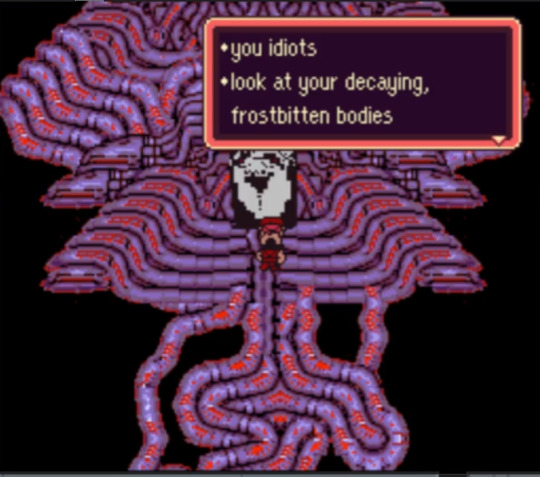
(image transcription: a screenshot of the main character fighting Andonuts from the end of the game. The text in the textbox from Andonuts says “you idiots. look at your decaying, frostbitten bodies”)
(and just as a side note, I think the reminiscence of this dialogue to Flowey’s dialogue in Undertale is funny and interesting)
Dr. Andonuts says the following: "If I can't live with myself, why should anybody else? Ergo, nobody will live. Then, everybody will understand all the pain I went through. When everyone understands me... They'll cherish me so." This isn’t the expression of a healthy mind, but it is a portrayal of someone who’s experiencing some serious pain. I’d also argue that it’s a nuanced and sympathetic portrayal of a character who is clearly in a crisis.
Another Andonuts quote: “you’re going to kill me, because that’s what a hero does. he has to kill that monster, right? even in this form, i am shaking with fear. i don’t want to die. leave me alone”
The second-to-last fight in the game is against an enemy called Id. In Freudian psychology, the Id is the representation of one’s most base desires, in contrast to the Superego who restrains a person from operating on these desires. The game up until this point does a good job at portraying Dr. Andonuts’s Superego-centric repression strategies, so getting to see his underlying base desires directly is a novel development. The enemy Id consistently reiterates a desire to be left alone and for the main character to not kill it. At the end, it apologizes for not being much of a fight. Only then does Varik fight Dr. Andonuts proper, and without the Id, all that’s left is the Superego-fueled repression, labeled in-game as “hatred”.
Andonuts’s villain monologue starts as such: “I know what this feeling is. It’s hatred for the person who came so far just to destroy an old man. My mind is gone. All that is left is pure hatred.
YOU SEE THIS BURNING, BLOODY UNIVERSE. YOU SEE THIS ULTIMATE, UNLIMITED POWER? Varik. I HAVE FUCKING HAD IT WITH YOUR SHIT. you little fuckers are going to have your bodies ripped in half. i’ll shove your asses so far down your throats that when you crap, you’ll sing fucking beethoven.”
This monologue is the precursor to the infamous line:

(image transcript: a screenshot from the final battle, in which Andonuts says the words “tl;dr: eat shit, faggots”)
As established earlier, this is a line uttered by a gay character who is in a tremendous amount of pain, which would make it an act of slur reclamation. We could argue about whether Toby Fox is in a position to justify this usage, but I refuse to have that conversation because I don’t think real life queer people should have to out themselves in order to justify the art they make. Whether Toby Fox is actually queer or not is, I would argue, immaterial to the story he’s trying to tell here, which is nuanced in a way that a homophobe would be unlikely to write.
We can also have the conversation of whether this word choice is a good decision or not-- and there are, I would argue, a lot of parts of this game that a storyteller with more experience and maturity would have handled better. There are some parts that come across heavy-handed and needlessly edgy, and there are parts that could have been handled with more grace. We can discuss whether “bury our gays” stories were stale by 2008, or whether stories of queer pain had fallen out of vogue for stories of queer joy. But again, this is a work made by a 16-year old, and being needlessly critical of a fangame made by a teenager for a community of predominantly teenagers feels needlessly meanspirited. Just because the game has been unforeseeably thrust into the public light like this doesn’t mean we need to eviscerate it from a 2023 lens. It’s not fair to Toby Fox, neither the original 16-year old creator nor the adult celebrity today.
So I’m not going to do that. What I am going to say is that a queer reading of this work would indicate that this word usage may very well have been a decision made with artistic intent, and a death-of-the-author reading of this work might indicate that this word has artistic merit anyways. If a gay character sees gayness as bad and uses a slur associated with gayness to demean his opponent, that does fundamentally say something about this character, and in this case it reinforces the existing themes that Toby had put in place. I wouldn’t recommend people in 2023 take this approach in storytelling lightly, but I can see and appreciate the spirit in which the game and this word choice appear to have been made.
In the end, Varik does defeat Dr. Andonuts and kill him.

(image transcript: Varik standing above the machine containing Dr. Andonuts’s dead body, not depicted onscreen. The text box reads “You feel a little like this situation could have been avoided.”)
This is one of the last text boxes of the game, and I think it’s a good ending note for this work-- saying that queer lives do NOT need to go this way, that we do not need to bury our gays, that this genuine pain that Dr. Andonuts experienced is not an inevitability.
In conclusion, I do love Halloween Hack for what it is, imperfections and all. It was very clearly a labor of love made by a very earnest and well-meaning teen, and a lot of the things that would later go on to make Undertale so popular are present in their nascent forms here. HH has some genuinely interesting things to say about Earthbound, from both a plot and a character standpoint, and it’s clearly a good-faith attempt at grappling with queer and psychological subject matter. If people on the internet were to engage sincerely with it rather than judging it (and its creator) based on one out-of-context screenshot, I think they might find a diamond-in-the-rough that still manages to be an absolute gem of a fangame.
69 notes
·
View notes
Text
like there comes a point where you think something is fundamentally wrong with you. and then it turns out it’s just Friday and you haven’t washed your hair in three days and maybe you’re also just a little lonely and the combination of all three of those things is whittling a hole into your chest every time you breathe. but also the sun’s up. and you’ve survived everything so far, so you’ll survive this too, even if it hurts, even if you have to survive it many times.
90K notes
·
View notes
Text
I keep rereading the sentence "the students are not allowed to bring their own books from home because they have not been approved" over and over like it will make it any better. It's like the world just became a tiny bit more of a 1984-esque hellscape for kids when I wasn't looking.
I read 1984 from a library, by the way.

237 notes
·
View notes
Text
I was a pre-animation major in college. We should be treating a digital interpolator as a MASSIVE GOOD THING.
Quick history of animation lesson: tweening is the process of filling in the frames "in between" the start and end of an action. If I'm animating someone doing a jumping jack, I need a keyframe of that person with their hands straight up, and a keyframe of their hands sticking out... But I also need 10-40 frames of that wrson at every tiny interval in between. That's 10-40 full-fledged individual drawings that all look almost identical to each other but with tiny, incremental changes between them. These frames need to exist for the final product, but they are also considered to be the "grunt work" of animation, the kind of work historically left to junior artists so the senior artists can work on the much more interesting keyframes.
The animation industry has been finding ways to make tweening less painfully laborious for DECADES. Disney had complex analog machines for animating backgrounds in early/mid 20th century. Adobe Flash was a program used to make animation in the 2000s, and they had an algorithm for calculating out tweens back then. Sometimes these tweens would look really bad and need to be animated by hand, but for simple actions like a plane flying across the sky at a uniform speed or a front-facing windmill rotating, these are huge time savers and absolutely a good thing! There isn't a ton of creativity in animating a front-facing windmill rotating at a uniform speed. Humans, particularly humans operating under budget constraints, tend to prefer to focus their efforts on more interesting animation tasks, so we make computers do that basic stuff when we can.
So yeah, I have zero objections to artists-- who are *already being paid money* to make a film-- using digital interpolators to automate the most obnoxious parts of their job. This will remain true in my mind whether or not the internet decides to conflate digital interpolators with the everpresent bogeyman of AI.
Automation can be scary. The idea of a computer doing a person's job better than them can be genuinely scary, and the conversation around when it is and isn't good for automation to automate someone out of a job is complicated because it spans far beyond art. And the conversation behind AI and disruptive innovation and copyright and everything else is also complicated. But at the end of the day, automation can also be a massively good thing. It can help the people who make your favorite cartoons work faster and more efficiently so they can spend more time on the parts of their job they like and make more of the content you love. And with a powerful set of legal guidelines, I have a hunch AI could be used in the same way. It's not inherently evil. It's a tool that good people can use for good purposes.
In writing this, I have made the cardinal sin of having a public opinion on the internet. I write this in 2023 when society is still figuring out how we do and do not want to incorporate AI into our lives. I have no idea what developments are yet to happen in the future. But even if things go absolutely sideways in some way, there was always the possibility for us to do better.
In case you're still reflexively on the fence when I proclaim that the conversation about AI has progressed to a truly batshit level of reactionary mythology, people on twitter are currently calling out the animators for Spiderverse for using a digital interpolator to assist with lining, because a documentary used the term "machine learning" to describe it.
Apparently using digital tools is taking work away from real artists. I am excited for 6 months time when the discourse has evolved into "all movies should be hand-inked on the inside of Palaeolithic caves to escape the corrupting labour-stealing influence of the pencil".
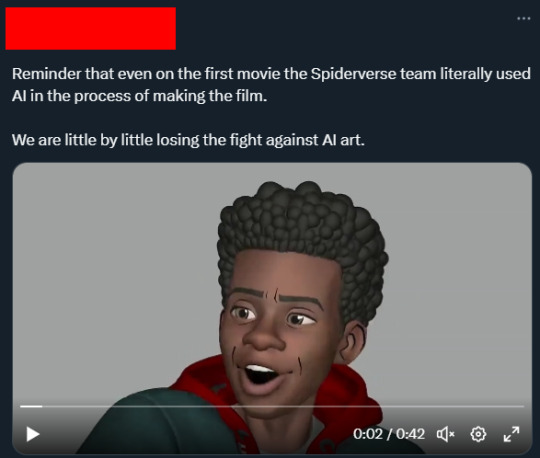

(Yes this is currently a minority opinion in this instance, largely because people just really like Spiderverse. But the fact that these arguments are being seriously made shows how far off the deep end this conversation has gone. These types of arguments for blanket technology bans already made little to no sense due to the double standard applied, and this demonstrates that by removing the double standard and taking them closer to their logical conclusion - all labour saving tools are bad, especially if they involve a spooky computer algorithm).
13K notes
·
View notes
Text
honestly the human brain is so small that you *will* forget how much beauty there is out there to experience unless you leave your house every three days. ik its fucked up but i promise its true
109K notes
·
View notes
Text
2023 gothic
i hate you ai art i hate you "unalive" i hate you youtube premium i hate you twitter 8$ checkmark i hate you nfts i hate you therapy app advertisements i hate you non-chronological timelines i hate you instagram reels i hate you subtle tiktok filters that cant be turned off i hate you family bloggers i hate you ads on true crime episodes i hate you facebook i hate you vr glasses on chickens i hate you dystopian social media
145K notes
·
View notes
Text
honestly the human brain is so small that you *will* forget how much beauty there is out there to experience unless you leave your house every three days. ik its fucked up but i promise its true
109K notes
·
View notes
